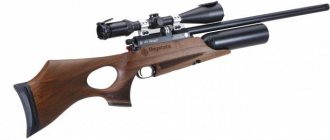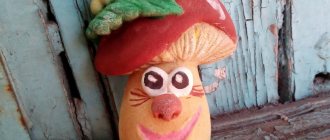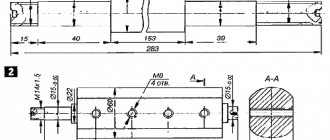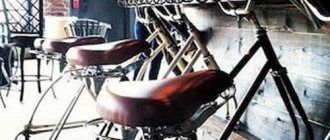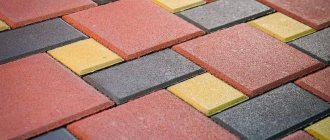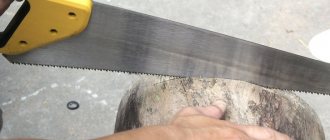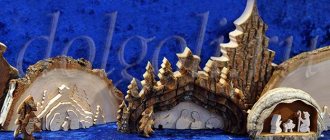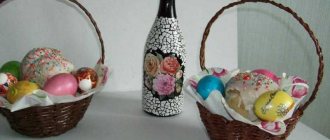Everyone knows that wood cannot be left to its own devices - under the influence of external forces it quickly collapses. Impregnation with antiseptics and fire retardants is required. But there is another effective protection, without the use of “chemistry”
Many centuries ago, our ancestors noticed that if you burn a piece of wood a little, it will become stronger. This technique, called Shou Sugi Ban (“cedar languishing”), is believed to have originated in Japan. Although there is quite reliable evidence that wood was processed this way on all continents, including ours. In Rus', pile pillars, joists, floorboards, wall cladding and roofing were protected by firing (smoking).
Today, the ancient method of heat treatment of wood is not only not forgotten, but is becoming more and more popular. The development of technology has made it possible to bring it to perfection. The wood is burned using a gas torch/blowtorch or kept in a kiln, resulting in a new, improved material.
Under the influence of high temperatures, all possible “seeds” of decay die. Wood sugar burns out, making the wood unappetizing to wood-boring beetles and other harmful microorganisms. The melted resin closes the pores of the material, making it less hygroscopic, or, in simple words, no longer “afraid” of water.
As strange as it may sound, charred wood becomes fireproof. It is almost impossible to re-ignite an already burnt board.
But that is not all. During the smoking process, the wood becomes amazingly beautiful. It darkens, becoming dark chocolate or impenetrable black, and acquires a noble silvery sheen that cannot be achieved by any paints.
Of course, such interesting characteristics attracted the attention of craftsmen from various fields. Today, charred wood is used everywhere. It shows itself perfectly both in the decoration of houses (floorboards, cladding of walls, ceilings, facades and roofs) and in landscape design (fences, pergolas, gazebos, greenhouses and even framing beds)
.
Another area of application is the furniture industry
. The exquisite black color with a pearlescent sheen has made Shou Sugi Ban wood a favorite material for designers creating luxury interior items.
What is it needed for?
Of course, the easiest way is to go to the construction market, buy varnish and coat a wooden product with it.
But the chemical composition of the varnish constantly releases fumes into the environment, albeit small, but harmful to human health. This is facilitated by temperature exposure, sunlight and even the operation of heating radiators. Finally, not all materials are easy to process; a different approach is required. This is where wood burning comes to the rescue. It works like this: during heating, which is constantly under the control of the master, processes begin in the outer wood layer that stimulate the narrowing of the fibers. And the outer pores are closed by soot and resin.
This decorative method of changing the characteristics of wood is not very complicated. And although you have to deal with fire, the technique itself is elementary. Usually gas burners are used for firing. There should be safety equipment nearby: a fire extinguisher and a bucket of sand. In ancient times, craftsmen made do with torches, and the log was gradually turned over on leather ties. This could be called either firing or simmering. Cedar, ash, beech and maple were taken more often than other species.
It is very important that the material itself does not burn during the firing process, but rather becomes scorched. This added special beauty to it and protected it from moisture and decay, and pathogenic organisms. After firing, it was necessary to remove the deposits, wash the workpieces and soak them in oil
In addition to protection, the tree acquired a special shade. Today, in this way, wooden products are given an “antique” effect. The service life of such a product increases significantly
After firing, it was necessary to remove the carbon deposits, wash the workpieces and soak them in oil. In addition to protection, the tree acquired a special shade. Today, in this way, wooden products are given an “antique” effect. The service life of such a product increases significantly.
History of the technology
Residents of Japan were among the first to burn wood to save their homes from fires. They massively burned the forest strips of cypress and cedar adjacent to the villages in order to protect the economy and buildings. After all, burnt, charred wood became perfectly protected not only from further fire, but also from biological destruction.
These new useful properties could not help but impress the artisans, and soon wood burning formed an entire technology that received a poetic name, which translated from Japanese sounds like “cedar languishing.”
Wood burning was widespread outside the Land of the Rising Sun. Craftsmen on many continents have used this method of protecting timber and structures. In Rus', this method was called “smoking.” To do this, they used the flame of a fire, under the influence of which the lumber and structures of future buildings were scorched. Firing is an excellent protection for piles and foundation formwork from groundwater and rot. And elements of the rafter system and roof fired using this technology are more resistant to exposure to sunlight and precipitation.
Charcoal firing in the field
The simplest method of fire treatment is best suited for deep firing. Decorative beams are treated in this way, as well as wooden siding and block houses for exterior decoration. Due to deep heating, the wood becomes impervious to atmospheric influences, and the influence of sunlight does not affect it at all.
For charcoal firing, dig a narrow trench about 30 cm deep and a width corresponding to the size of the parts being processed. A fire is built in a ditch, and as it burns, the wood is constantly stirred, achieving rapid charring. After this, the ditch must be covered with either sheet iron or a strip of OSB to temporarily prevent the access of oxygen and stop the combustion.
Before laying the workpiece in the coals, you need to rake out the central furrow so that during firing, not only the lower part, but also small areas on the sides are processed. The holding time of the workpiece depends on the thickness and can range from two to three to fifteen minutes. After this, the workpiece is turned over to the opposite side, and then, after maintaining the same period of time, it is burned on the sides.
It will be easier to remove the workpiece with a pair of steel wire hooks. After the wood is removed from the coals, it is immediately doused with water.
Charcoal
This type of coal is not a fossil, so it has some peculiarities in its composition. It is produced by heating dry wood to a temperature of 450-500 oC without air access. This process is called pyrolysis. During this process, a number of substances are released from the wood: methanol, acetone, acetic acid and others, after which it turns into coal. By the way, burning wood is also pyrolysis, but due to the presence of oxygen in the air, the released gases ignite. This is what determines the presence of flames during combustion.
Wood is not homogeneous; it has a lot of pores and capillaries. A similar structure is partially preserved in the coal obtained from it. For this reason, it has good adsorption capacity and is used along with activated carbon.
The humidity of this type of coal is very small (about 3%), but during long-term storage it absorbs moisture from the air and the percentage of water increases to 7-15%. The content of inorganic impurities and volatile substances is regulated by GOSTs and should be no more than 3% and 20%, respectively. The elemental composition depends on the production technology, and looks approximately like this:
- Carbon 80-92%.
- Oxygen 5-15%.
- Hydrogen 4-5%.
- Nitrogen ~0%.
- Sulfur ~0%.
The chemical formula of charcoal shows that in terms of carbon content it is close to stone, but in addition it has only a small amount of elements unnecessary for combustion (sulfur and nitrogen).
Interior use
Burnt wood is used by designers everywhere. Art workshops and various studios allow you to purchase interesting furniture, a chandelier or a lamp made of wood. Options for using burnt boards in the interior.
Furniture can be made from smooth, processed boards or rough-hewn beams. In any case, it is highly appreciated. Sometimes it is not even used for its intended purpose, but is used only as a decorative element.
The floor covering after firing requires leveling. For this, simple epoxy resin is used. She does an excellent job and does not require any special skills to work.
Foundation preparation
After delivery, it is better to immediately place the metal structure at the place of intended use. To do this, it is necessary to prepare the foundation taking into account the following factors:
- relief of the site;
- GWL level;
- soil type;
- snow and wind loads.
On flat terrain and gravel, coarse sand and rocky soil, a garden house can be placed without a foundation, on a crushed stone bed compacted with a vibrating plate. With a low groundwater level on a flat area, the dacha is usually supported by pillars made of reinforced concrete or solid wall blocks.
Screw piles have no restrictions on geological conditions and terrain. For a 20-foot container, 6 piles with a load-bearing capacity of 1.5 tons each are sufficient. The most convenient option for such a home is considered to be a foundation with a plinth and technical underground.
Communications must be brought into the area before installation, and a hatch must be cut into the metal floors to connect them.
What types of wood are best suited for fire processing?
It is believed that any wood is suitable for firing. However, for those who want to get a unique visual effect, experts recommend using only certain breeds. It is noteworthy that initially only cedar was used in traditional Japanese technology. Later they began to treat beech and hornbeam with fire. When burned, such wood acquired a gray color that shimmered beautifully in the light. This effect can be achieved by burning the top layer of wood.
Today, species such as maple, alder, and poplar are especially popular in firing. If you need to get a surface with a fine texture, then in such cases larch and walnut are used.
When building baths, only birch is used. When exposed to fire, this type of wood becomes porous and acquires a low heat capacity. Thanks to this, when exposed to temperatures, it cannot burn the skin.
An interesting fact is that the same wood can appear in different ways. It directly depends on the firing method
But in any case, it is important to properly prepare the material for processing.
Wood for firing should have little moisture. The maximum acceptable is 13%. In addition, the material should not have traces of paint and varnish coatings. It must be completely cleaned
In this case, this is important, because resinous substances absorbed into the wood will appear unevenly on its surface during firing. This will significantly spoil its appearance.
Materials
Any wood can be used for firing. However, breeds with an unusual and pronounced texture are more popular. Japanese technology originally used cedar. Beech and hornbeam boards are no less popular and have high decorative properties.
More valuable species are processed more often. If you burn maple, poplar or alder, the texture will become more elongated. Walnut and larch form fine and highly textured patterns on the surface. Birch is most often used for the construction of baths.
Coniferous trees are also burned. Their peculiarity lies in the variety of resulting patterns. The structure after processing is truly amazing. It is noteworthy that small drawings are always different - repetitions are excluded. Pine board is especially popular.
It should be understood that the material requires certain preparation before firing. Thus, wood with a humidity level of no more than 13% is used. The material should not be coated with drying oil or paint. The presence of such treatments will spoil the drawings; they will appear unevenly due to the high temperature.
How does firing affect wood?
The structure of wood fibers is always uneven: in the process of life, cellulose polymers of varying degrees of stability, as well as sugars and resins of all kinds, are formed in wood. It is the presence of pores and organic nutrient residues that cause the main disadvantages of wood: flammability and the presence of a nutrient medium for the development of bacteria and fungi.
The opportunity to “seal” wood from the influences of the outside world still exists. It is used during creosote boiling of wood or during autoclave heating (thermolysis). When heated to 300–400 °C, almost all unstable hemicellulose formations are destroyed, and they serve as both a “launching pad” for the ignition of wood (forming the primary volume of flammable pyrolysis gases) and the initial breeding ground for the development of colonies of harmful organisms.
It is incredibly difficult to reproduce such wood processing at home. But it is quite possible to partially clog the internal pores and remove most of the unstable cellulose polymers. Even surface firing can heat the outer layer (5–20 mm) of wood enough to melt lignin and resins and form an inorganic crust that protects against most external influences. After proper firing, wood is almost impossible to re-ignite without intense and prolonged heating to 500–700 °C. In this case, the residual heat kills microorganisms remaining in the thickness of the wood, and the sintered outer layer prevents the penetration of pathogenic organic matter from the outside.
Rare types of firewood
Oak
– the best firewood for the stove. The wood is dense, burns for a long time, gives high heat transfer, and is very economical, because compared to other firewood, much less is consumed to heat the same area. Due to its high cost, it is often used as an additive to other wood. A pair of oak logs will make the burning more intense and longer.
Good oak firewood comes from middle-aged trees; when burned, they release a pleasant tart aroma. Oak firewood is ideal not only for stoves, but also for fireplaces.
Excellent, but also one of the most expensive - alder
firewood. They burn hot, without smoke or soot, spreading a pleasant aroma.
Alder cannot be confused with any other firewood; when cut, it has a color from yellow to deep red. Perhaps this is the best firewood for a fireplace; it burns with a mesmerizing, even flame of a beautiful color. A big plus is that alder firewood lasts a long time and can be stored for future use for 5-6 years.
Rare firewood includes linden
. Although linden is common, linden firewood is rare. The wood is hot, although it takes a long time to burn, but then the stove heats up very quickly. The aroma that comes from linden when burned has healing properties. A bathhouse heated with linden firewood is useful for colds, diseases of the bronchi and lungs, and has a beneficial effect on the condition of the skin.
Regardless of what type of firewood you purchase, make sure that the wood is not rotten. The benefits of rotten mushrooms are zero. In order for the wood to burn, giving off maximum heat, it must be dry. Undried wood burns poorly, produces a lot of smoke and little heat.
For thousands of years, our ancestors used wood (firewood) as fuel. And today, despite the widespread use of natural gas or coal, they remain a popular type of fuel.
At the dacha or in the countryside you can’t do without them. Wood from different trees can be used as fuel. They all have their own characteristics.
What will you need?
On an industrial scale, large volumes of wood are fired in vacuum kilns. Layers of wood up to 20 mm thick can burn. It’s difficult to achieve this effect at home, but other, more modest results are also impressive. And the main thing is that they can be achieved using more accessible tools.
The source of flame for firing can be:
- high power blowtorch;
- gas-burner;
- construction hair dryer;
- gas cylinder with nozzle, etc.
You will also need a tool that will clean off the burnt layers. If you have to burn small boards, the amount of work is not very significant, you can get by with a simple metal brush. But it’s convenient to tackle massive structures, such as furniture, stairs, floors, and even buildings, using a grinding machine, a grinder saw, or even a drill with an attachment.
You will also have to sweep away the remains of the burnt material, and a flute brush or soft-bristle brush does a good job of this. Naturally, all work must be carried out in compliance with all safety measures. It is imperative to protect your eyes, clothes and hands so that sparks and fumes do not threaten them. A bucket of sand, water, and a fire extinguisher should be within easy reach.
What determines combustion efficiency?
Combustion efficiency is an indicator that is determined by thermal energy, which does not “fly down the chimney”, but is supplied to the furnace and heats it. This indicator is influenced by several factors.
First of all, this is the integrity of the stove structure. Gaps, cracks, excess ash, unclean chimney and other damage make combustion ineffective.
The second key factor is the density of the tree. The highest densities are found in oak, ash, pear, larch and birch. The smallest are spruce, aspen, pine, linden. The higher the density, the longer a piece of wood will burn, which means the longer it will release heat.
Design
The Japanese art of wood decoration is very popular. In essence, this is an artistic material from which a lot of interior items and finishing elements can be made. The result depends on the type of firing and the material used. As a result of a combination of a number of factors, the board acquires a certain color and texture. Types of firing.
Surface. This type of processing is used more often than others due to its simplicity. This type of firing will require a minimum of experience, skills and free time. You can use a gas torch or soldering iron if the process is carried out at home. Processing is carried out to a depth of no more than 5 mm
It is important to carefully go over all parts of the board to achieve the perfect result. Firing should be uniform over the entire area
Texture
With light exposure to fire, the wood acquires a weakly expressed texture, and with full exposure, an interesting pattern appears, which consists of interlacing wood fibers. Each type of tree shows itself uniquely. Dense material will have the most pronounced grooves. Soft wood will give a sparser pattern.
The floorboard is usually fired superficially and additionally leveled. Decorative items, benches and other furniture are made from material with any texture.
Color
Deep firing makes the wood blue-black, it literally resembles the shade of coal. If the treatment is superficial, the natural color remains virtually unchanged. The material can have any shade in the beige-brown palette.
Some types of wood are more interesting. For example, when hornbeam and beech are fired, a gray and anthracite tint appears. Also, the board or beam can be painted on top in any color. It is worth noting that during processing the natural color is usually preserved. So, burnt wood can be either gray, light, or black, dark brown.
Fire safety requirements when handling fire
You must always remember that when handling fire, the key to successful actions is compliance with fire safety rules. Make a few conditions and protect yourself and others from fire.
1. The ban on making fires in the wilderness in the summer was not introduced without reason. In summer, the chances of the forest floor catching fire and quickly starting a fire are much higher than during the rest of the year.
2. When making a fire outdoors, first of all, dig a small fire pit, removing the layer of turf on top with a shovel. Subsequently, it would be a good idea to return the top layer of soil to its place.
3. In order to localize the fire, it is recommended to surround the fire with a fence made of stones or bricks.
4. There must always be a fire extinguishing agent in the walking distance area: a fire extinguisher, sand or a container of water.
5. When extinguishing a fire, first of all, make sure that all the coals have gone out and the fire will not flare up again. To do this, it is recommended to fill the fireplace well with water, sprinkle it with earth or lay it with a top layer of soil.
6. There is no need to leave children face-to-face with a fire source. This will lead to bad results.
7. When using a stove or fireplace, it is not necessary to keep flammable objects or ignition materials very close to the combustion chamber. It would be a good idea to make the floor covering next to the combustion chamber from a material that does not burn (steel sheet).
8. It is necessary to maintain the stove in working condition: seal all cracks that appear in a timely manner, and sometimes remove the ash.
9. The foundation for the furnace must be made of brick. Wooden scaffolding should not be used for such purposes. This is dangerous due to the collapse of the entire structure.
10. The chimney in the attic should be insulated with non-flammable material; flammable materials should not be stored in the attic.
11. You cannot completely close the stove damper without making sure that the combustion process in the combustion chamber has ended. Otherwise, suffocation from excess carbon dioxide may occur.
How to burn wood with a gas torch
Using gas burners is much easier. These can be either hand-held camping lamps or regular nozzles connected to the cylinder via a hose.
It is convenient to process wood with gas only by surface firing. Deeper aging in the fire will not be sufficiently uniform, as a result the product may have variable thickness and width. In addition, deep heating will require quite a lot of gas, while coals cost almost nothing.
When surface processing the wood, the very edge of the light blue torch is touched. The movements are roughly the same as when painting. At the same time, it is quite easy to control the firing depth based on the degree of darkening.
Firing is followed by wetting, but in this case an ordinary hand sprayer will suffice
It is important that the time interval between fire treatment and water spraying is the same for all areas of each part, so carry out the treatment sequentially.
Decorative value of burnt wood
Much more interesting is the visual effect of burning wood. It was thanks to him that the technology of processing wooden beams under the whimsical name “Shu-Sugi-Ban” was born in Japan, and the meticulousness of the Japanese to the interior design of homes is well known to everyone.
The appearance of wood processed in this way directly depends on the technique and depth of firing, and there are three types. The first - surface firing - allows you to create a brown-brown surface with a golden sheen, on which the wood texture appears quite contrastingly. The chemical and biological resistance of such wood is not high enough, so surface-fired products are used, as a rule, in interior decoration. Due to the fact that the impact on the structure of the wood is minimal, since firing affects only 2–5 mm below the surface, finishing materials can retain their lightness, that is, it is quite possible to process ordinary lining in this way.
Deep firing of wood is used for older lumber, often for boards and beams that have already been in use. This technique helps to “renew” the wood: remove the dried out surface gray layer and efficiently heat the entire thickness of the wood. Due to this, the surface acquires a very expressive appearance: from iridescent graphite to coal-black imitation of rare noble rocks. Perhaps, such a depth of black color cannot be achieved by other methods, which is why deep-fired wood is so highly valued by designers.
The third stage of wood processing is its complete burning. Actually, it ceases to be a tree at all, turning, in fact, into polymer-carbon plastic. At home, unfortunately, complete firing is almost impossible: during charring, the fire will have time to eat almost half the thickness of the workpiece. This wood is used primarily in the production of furniture. The technique guarantees the absolute uniqueness of each product, because the characteristic pattern and the resulting splits cannot be reproduced in any way.
What to process?
In principle, the material can be left in the same form, without changing anything, without resorting to any impregnation. But many craftsmen are sure that it won’t be superfluous to varnish and soak beautiful, renewed wood. Especially considering that this will increase the level of security of the material.
Oil better emphasizes the decorative characteristics of wood. And it will be used in this form even longer. And then you can also apply varnish on top of this treated surface, preferably nitrocellulose. A mixture of varnish and artificial wax is also suitable. But if it is the façade wood that needs to be treated, a turpentine-wax solution would be an excellent composition.
The best way to impregnate burnt wood is oil. Tung, flax and hemp are ideal options. It is more convenient to apply the liquid with a brush, although a spray gun will do. And this is the most environmentally friendly processing option (in combination with firing).
Tinted synthetic oil compounds are also used; they can visually transform simple wood types into noble ones. They very favorably accentuate the structure of the wood and protect it from external aggressive influences.
The most beautiful boxes, large wall panels, and baguettes are made from the fired material. It can also be used to make extravagant tables, chairs, solid chests of drawers and cabinets. Decorating walls with such textured wood is also attractive, especially in interior styles that are conducive to this - from chalets to lofts.
To learn how to burn wood with your own hands, watch the following video.
Application of burnt lumber
Finished burnt lumber and products made from it are highly valued by builders and designers. Doors, windows, gazebos and terraces, benches and tables, garden furniture and technical buildings are made from such wood. After firing, the wood is perfect for building fences and other enclosures, decorating floors and balconies, and exterior decoration of houses.
Using burnt wood in interiors
Flame-treated wood is perfect for many interior styles, especially country. After special varnishing or painting, it can be used in retro, vintage, Provence and other styles, which involve the use of artificially aged furniture and decorative items. Most often in the interiors of apartments and residential buildings you can see the following products made from burnt wood:
- caskets,
- panel,
- baguettes,
- chairs and tables,
- chests of drawers,
- lockers.
In addition, the complete decoration of walls with burnt wood or the design of beams and ceilings looks beautiful in the design of the premises. The unique type of material will provide a luxurious look to the entire house.
Finishing of burnt wood
After the wood has cooled, soot and soot are removed from it. For this purpose, brushes made of brass wire are used so as not to strip off excess. During mechanical processing, texturing or so-called artificial aging of wood can also be carried out.
Cleaned products can be installed immediately. Additional processing is needed not so much to protect the structure of the wood, but to preserve its color and overall appearance after years, as well as to eliminate soiling. For interior decoration, the lining is coated with linseed or hemp oil in several layers. Wood for facades and other external works is coated 1–2 times with colorless nitrocellulose varnish with the addition of synthetic wax: either with a brush along the grain or with a spray gun.
rmnt.ru
What species and what type of wood is best to burn?
Generally any wood is suitable for firing, but connoisseurs of subtle visual delights will most like species with an expressive and unusual texture. The original technology of Japanese origin initially used exclusively cedar. Burnt hornbeam and beech boards have an interesting appearance: due to the high density of such wood, only its top layer burns through, resulting in anthracite and gray tints of color.
More popular valuable species, such as alder, maple and poplar, exhibit an elongated texture after firing, while walnut or larch can form additional finer textured patterns. Burnt birch will be highly appreciated by bath or sauna lovers: due to firing, its surface becomes very porous and acquires a low heat capacity, so after heating it does not burn the skin.
It is also surprising that, depending on the degree of firing and the origin of the wood, even the same species can manifest itself in completely different ways. When using burnt wood in decorative finishing, you should take a thorough approach: stock up on samples of different types from different sources and, after a series of experiments, come to a certain choice.
Remember also that the wood must be properly prepared before firing. It should have low humidity, preferably no more than 12–13%, and also be natural, that is, without traces of painting or opening with drying oil. Otherwise, the absorbed resinous substances will appear unevenly on the surface and disrupt the appearance. Of course, a lot here depends on the depth and time of fire treatment.
Important Tips
In practice, it is not necessary to pre-prepare wood for firing. Due to the flame, all roughness will go away. This is an alternative for sanding. The appearance will have to be modified after heat treatment.
Regarding fire treatment, I want to give some tips:
- if the product is covered with putty or paint, you need to sand and remove traces of paint and varnish materials;
- When impregnating with stain, you do not need to do anything; you can fire according to the standard scheme;
- Products treated with drying oil should not be exposed to flame;
- old dark trees need to be sanded down to the level of fresh fiber, and then fired;
- raw material cannot be used for processing;
- The maximum humidity level is 15%.
Following these requirements, you can start working.
Structural changes in wood during firing
The structure of wood is such that when layers are built up under the bark, some kind of pores appear in it. As a result, the fibrous cells die. Thanks to high porosity and displacement of fibers, wood acquires its main and most valuable feature - excellent hygroscopicity. Thanks to this quality, it is able to give and absorb water depending on the difference in the humidity of the environment and its own.
The second no less significant feature is the unevenness of the structure. This is due to the formation of cellulose polymers, resins and sugars during the life of the tree. Such substances are the main organic components of the plant. They also cause the main disadvantages of wood - flammability and the formation of a favorable environment for fungi and pests.
In order to reduce the tree's exposure to external influences, several protection methods are used. First of all, this is autoclave heating and creosote cooking of wood. During the procedure, the material is exposed to high temperatures, due to which hemicellulose formations are destroyed. They are the main cause of wood fires. It is almost impossible to carry out such an operation at home. But there are a number of other more accessible methods for partially blocking pores and removing polymers. One of them is burning wood with fire.
Many people do not understand why wood should be subjected to such processing. Experts know that firing helps narrow the fiber channels of wood. In addition, they become clogged with resins and combustion products. Thanks to this, the service life of wood is extended for decades.
Which wood burns better and which burns worse?
Dry wood burns best. Wood soaked in moisture also burns, but it takes considerable temperature and some time to remove and evaporate the moisture. This process is in most cases accompanied by a distinctive hissing sound. Not everyone knows that when “damp” wood burns, vinegar acid is released. This fact shows up very poorly on furnace equipment and on the overall combustion efficiency. It is highly recommended to use dry firewood, and also buy firewood in the spring so that it has time to dry before the cold weather arrives.
Stages of work
How to carry out firing at home can be seen using the example of using a standard burner. Let's look at the step-by-step processing of a wooden piece with a gas burner.
- The flame of the device must be kept calm, even, and bluish. But they don’t burn with yellow fire.
- To process the wood evenly, you need to run the tool over the surface several times. The movements should be the same as if the board was being painted with a brush. It is more convenient to start from the top. The burnt board should be burnt 4 mm deep.
- Use a brush or sander to walk along the grain of the wood, trying not to damage the structure of the material. At the same time, the flute is also used.
- The cleaning process (you need to be prepared for this) is very painstaking and time-consuming. The detached soot must be completely removed. If you ignore this point, the workpiece will not look beautiful.
- You can check the quality of the work you have done yourself: wipe the wood with a napkin and a soft cloth. To enhance the relief, you can once again use firing followed by brushing.
The result of this work is a relief surface, the shade of which can be from soft golden to rich chocolate. Sometimes a layer of aniline dye is placed on the surface.
How to process wood using Japanese pyrolysis technology.
- It is necessary to remove the top ash layer from the wood. The boards must be washed in water and then thoroughly soaked in vegetable oil. This will help the wood become moisture-repellent, with antiseptic characteristics.
- The finished material will become dark silver and shiny. In the old days, this effect was achieved by simply sending the wood into a stove or fire, but today they turn to a burner.
Japanese craftsmen who burned wooden surfaces in this way protected houses from fires. The ash layer is not afraid of fire, therefore the Japanese firing method is optimal for objects and objects located on the street.
Processing a wooden product with a blowtorch is carried out with an extremely heated tool. The fire must be directed only perpendicular to the surface. How long to act depends on the workpiece and the final purposes of firing. All manipulations must be performed measuredly, without haste. The surface should gradually acquire contrast. Then the product is sanded, treated with drying oil or the same varnish.
Flash and ignition of industrial oil
These two parameters relate to high temperature critical operating points.
Definition
As the temperature of the material increases, its evaporation begins, forming a gas mixture above the surface. If you bring an open flame source to the resulting cloud, a quick-extinguishing flash will occur, which will not ignite the oil.
The lowest temperature at which the described process occurs is called the flash point of the substance.
If you continue to heat the material, at some point the oil itself will ignite, and the fire will last for five seconds or longer. At this moment, the combustion temperature of the oil is recorded.
Causes
Firstly, the thermal parameters of a substance can change during its operation. When using a lubricant, oxidation processes and internal chemical reactions occur. Mixtures with varnishes and paints are formed, carbon deposits appear, inclusions of small particles formed during friction of engine parts.
These processes are accelerated when the unit operates at elevated temperatures and self-ignition.
Secondly, when a fuel leak occurs, for example, in a car engine. Gasoline or diesel fuel have lower thermal flash ratings. When mixed with lubricant, they lower the flash point of engine oil.
For fuel, the flash point is determined in a closed crucible in accordance with GOST 6356-75, while for motor oils the Cleveland method (open) is used.
Let's consider the values of thermal indicators for some liquids.
| Product | Flash point, °C |
| Motor gasoline | –39 |
| Diesel fuel | 78 |
| Fuel T-1 | 28 |
| Motor oil MK-22 | 259 |
| Lubricant TP-22 (turbine fluid) | 198 |
| Industrial oil I5A I20A I50A | 140 200 225 |
| Naval fuel oil F-12 | 158 |
| Ethanol | 13 |
The table shows that the thermal performance of the fuel is noticeably lower than that of substances used to lubricate engines.
For example, unrefined sunflower oil becomes unsuitable for consumption already at 107 °C. And the highest heat treatment can be carried out using ghee. It maintains characteristics up to 252 degrees Celsius.
Signs
Reasons to suspect a critical increase in temperature in the engine may be:
- readings from instruments that are mounted in cars and on some industrial equipment: if the thermostat needle approaches the red zone, measures must be taken to cool the mechanism;
- the characteristic sound of lubricant boiling or a popping sound during a flash;
- the appearance of smoke around equipment or from under the hood of a car;
- car exhausts are black.
If one or more signs of engine overheating occur, you should immediately begin to eliminate the problem that has arisen.
Danger
When overheating, the viscosity of the lubricant decreases.
This in turn leads to:
- reducing the gap between mechanism parts;
- acceleration of oxidation processes, entry of the composition into chemical reactions, aging of the oil;
- the appearance of soot and deposits that can provoke a detonation explosion of the engine;
- the formation of a film that is baked on internal surfaces;
- flash and fire of a mechanism that can destroy equipment or a vehicle in a matter of minutes.
